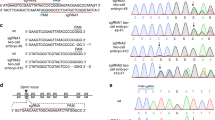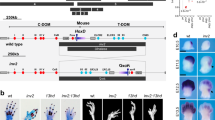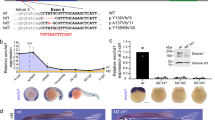Abstract
The mouse homoeobox-containing genes exhibit temporally and spatially specific patterns of expression in embryonic and adult tissues and are thought to be important in regulation of development and cellular differentiation, perhaps by mechanisms analogous to homoeotic genes in Drosophila melanogaster1–4. There has been no direct demonstration that expression of these mammalian genes can affect developmental processes, however. Hox-1.4, like other mouse homoeobox-containing genes, has been shown to be expressed in specific regions of the mid-gestation embryo5–8, but is unique in that its highest level of expression in the adult animal is restricted to developing male germ cells5,8,9. We have introduced a construct carrying the mouse Hox-1.4 gene into the germ line of mice to begin to identify the m-acting elements required for proper expression and to assess the consequences of increasing Hox-1.4 gene expression. The construct was designed to produce normal Hox-1.4 protein from transcripts that are distinguishable from the products of the endogenous gene. The integrated transgene seemed to exhibit the appropriate tissue specificity of expression, but transcript levels were elevated in certain tissues, particularly the embryonic gut. This overexpression correlated with changes in the normal developmental program of the gut, resulting in an inherited abnormal phenotype known as megacolon.
This is a preview of subscription content, access via your institution
Access options
Subscribe to this journal
Receive 51 print issues and online access
$199.00 per year
only $3.90 per issue
Buy this article
- Purchase on Springer Link
- Instant access to full article PDF
Prices may be subject to local taxes which are calculated during checkout
Similar content being viewed by others
References
Gehring, W. J. Science 236, 1245–1252 (1987).
Ingham, P W Nature 335, 25–34 (1988)
Holland, P W H. & Hogan, B L. M. Genes Dev. 2, 773–782 (1988).
Dressler, G R. & Gruss, P. Trends Genet. 4, 214–219 (1988).
Wolgemuth, D J et al. Proc natn. Acad. Sci. U.S.A. 84, 5813–5817 (1987).
Wolgemuth, D J. et al. Cell to Cell Signals in Mammalian Development (Springer, Berlin, in the press).
Toth, L E., Slawin, K. L., Pintar, J. E. & Nguyen-Hun, M. C. Proc. natn. Acad. Sci. U.S.A. 84, 6790–6794 (1987).
Rubin, M R, Toth, L. E., Patel, M. D., D'Eustachio, P. & Nguyen-Huu, M. C. Science 233, 663–667 (1986).
Wolgemuth, D. J. et al. EMBO J. 5, 1229–1235 (1986).
Duboule, D., Baron, A., Mahl, P. & Galliot, B. EMBO J. 5, 1973–1980 (1986).
Bucan, M. et al. EMBO J. 5, 2899–2905 (1986).
Odenwald, W. F et al. Genes Dev. 1, 482–496 (1987).
Fibi, M. et al. Development 29, 349–360 (1987).
Monesi, V Expl. Cell Res. 39, 197–224 (1965).
Kierszenbaum, A. L. & Tres, L. L. J. Cell Biol. 60, 39–53 (1974).
Gershon, M. G. Fidia Research Foundation Neuroscience Award Lectures, 1966 108–143 (Livinia, Padua, 1987).
Lane, P W. J. Hered. 57, 29–31 (1966).
Lane, P. W. & Liu, H. M. J. Hered. 75, 435–439 (1984).
Principles in Internal Medicine 9th edn, 1420 (eds. Isseldacher, K. J., Adams, R. D., Braunwald, E, Petersdorf, R. G. & Wilson, J. D ) (McGraw Hill, New York, 1980).
Duggal, R. N., Zakeri, Z. F., Ponzetto, C. & Wolgemuth, D. J. in Cell Biology of the Testis and Epididymis (ed Orgebin-Chnst, M. C.) (Ann. N.Y. Acad. Sci., New York, 1988).
Fiers, W Nature 273, 113–120 (1978).
Brinster, R. L, Chen, H. Y., Trumbauer, M. E., Yagle, M. K. & Palmiter, R. D. Proc. natn. Acad. Sci. U.S.A. 82, 4438–4442 (1985).
Cathala, G et al. DNA 2, 329–335 (1983).
Aviv, H. & Leder, P Proc. natn. Acad. Sci. U.S.A. 69, 1408–1412 (1972).
Maniatis, T., Fritsch, E. F. & Sambrook, J. Guide to Molecular Cloning (Cold Spring Harbor Laboratory, Cold Spring Harbor, New York, 1982).
Ponzetto, C & Wolgemuth, D. J. Molec. cell. Biol. 5, 1791–1794 (1985).
Weinstock, R., Sweet, R, Weiss, M., Cedar, H. & Axel, R Proc. natn. Acad. Sci. U.S.A. 75, 1299–1303 (1978).
Mutter, G. L. & Wolgemuth, D J Proc. natn. Acad. Sci. U.S.A. 84, 5301–5305 (1987)
Author information
Authors and Affiliations
Rights and permissions
About this article
Cite this article
Wolgemuth, D., Behringer, R., Mostoller, M. et al. Transgenic mice overexpressing the mouse homoeobox-containing gene Hox-1.4 exhibit abnormal gut development. Nature 337, 464–467 (1989). https://doi.org/10.1038/337464a0
Received:
Accepted:
Issue Date:
DOI: https://doi.org/10.1038/337464a0
This article is cited by
-
The construction of transgenic and gene knockout/knockin mouse models of human disease
Transgenic Research (2012)
-
Gene expression profiling of intestinal regeneration in the sea cucumber
BMC Genomics (2009)
-
The Hlx homeobox transcription factor is required early in enteric nervous system development
BMC Developmental Biology (2006)
-
Hoxgenes, Arms and the Man
Nature Genetics (1997)
-
Enx (Hox11L1)-deficient mice develop myenteric neuronal hyperplasia and megacolon
Nature Medicine (1997)
Comments
By submitting a comment you agree to abide by our Terms and Community Guidelines. If you find something abusive or that does not comply with our terms or guidelines please flag it as inappropriate.



